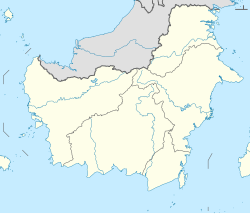|
Kapuas Regency
Kapuas Regency (Indonesian: Kabupaten Kapuas) is one of the thirteen regencies which divide Central Kalimantan Province, on the island of Kalimantan, Indonesia. It formerly covered a wider area, but on 10 April 2002 two further regencies (Pulang Pisau Regency and Gunung Mas Regency) were cut out of its western districts, and the residual area is now 17,070.39 km.2 Its population was 329,646 at the 2010 Census[2] and 410,446 at the 2020 Census;[3] the official estimate as at mid 2023 was 425,186 (comprising 219,045 males and 206,141 females).[1] The administrative centre is the town of Kuala Kapuas near the coast, but the largest town is Selat, which includes 8 of the regency's 15 urban kelurahan, and had 72,382 inhabitants in mid 2023. GeographyThe total area of Kapuas Regency is 17,070.39 square km (11.1% of the area of Central Kalimantan Province), delineated into ebbtide and non-ebbtide areas.[4] It adjoins Gunung Mas Regency, the Java Sea, Barito Selatan Regency and Kalimantan Selatan Province (Barito Kuala Regency), and Pulang Pisau Regency, to the north, south, east and west, respectively. The north is marked by hills and mountains up to 500 metres above sea level, while the south is coastal and marshy, ebb-tidal and vulnerable to flooding. Rivers in Kapuas Regency are the Kapuas and Kapuas Murung, 600 and 66.38 km in length, respectively. There are four canals: Anjir Serapat (28 km in length;) and Anjir Tamban (25 km), each connecting Kuala Kapuas with Banjarmasin, running through Kalimantan Tengah (for 13–14 km) and Kalimantan Selatan (12–14 km); the Anjir Kalampan (14.5 km), connecting Mandomai, the capital of Kapuas Barat district, with Pulang Pisau Regency; and the Anjir Basarang (24 km), connecting Kuala Kapuas with Pulang Pisau. AdministrationIn 2009 there were 204 villages (190 rural desa and 14 urban kelurahan). These were categorised as 44 traditional (swadaya), 61 transitional (swakarya) and 59 development (swasembada) villages, 6 isolated villages/wards (2.94 percent) and 52 poor villages/wards (25.49 percent). In 2009, there were 190 desa heads, 160 desa secretaries, 950 desa staff, 14 kelurahan heads and 14 kelurahan secretaries. In 2023 there were 231 villages, comprising 214 rural desa and 17 urban kelurahan. Administrative DistrictsKapuas Regency consists of seventeen districts (kecamatan), tabulated below with their areas and population totals from the 2010 Census[2] and from the 2020 Census,[3] together with the official estimates as of mid 2023.[1] The 2020 Census figures are rounded to the nearest 100 people. The table also includes the locations of the district administrative centres, the number of administrative villages (totaling 214 rural desa and 17 urban kelurahan) in each district, and their postal codes.
Notes: (a) includes the offshore island of Pulau Roko. (b) comprising 8 kelurahan (Murung Keramat, Panamas, Selat Barat, Selat Dalam, Selat Hilir, Selat Hulu, Selat Tengah and Selat Utara) and 2 desa. ClimateKapuas Kuala, the seat of the regency, has a tropical rainforest climate (Af) with heavy rainfall in all months except July and August.
PopulationThe 2010 census recorded 329,646 people, including 167,937 males (50.98%) and 161,503 females (49.02%). The 2020 Census total rose to 410,446, and the population was 423,210 in mid 2022.[6] The 2020 population density was 27.36 people/km2, ranging from a high of 624.66 in Selat to only 5.07 people/km2 in Mandau Talawang. DemographicsReligion as of 2018:[7]
SocialEducation is a development sector given priority by government (1945 Constitution mandate, as stated in article no 31 point 2), with an ultimate aim of improving the quality of human resources in Indonesia. There were 147 kindergartens in the regency, with 390 teachers and 4,181 students in 2009. In 2010, there were 390 Primary schools (including private schools), with 2,736 teachers and 40,714 students, yielding student:teacher ratio of about 14.88. There were 86 Junior High schools (state and private), with 1,085 teachers, 9,667 students and 465 classrooms; 25 Senior High schools (state and private), with 636 teachers and 5,886 students. The region had only 38 doctors in 2010, resulting in a service ratio of 8,669. References
External links |
|||||||||||||||||||||||||||||||||||||||||||||||||||||||||||||||||||||||||||||||||||||||||||||||||||||||||||||||||||||||||||||||||||||||||||||||||||||||||||||||||||||||||||||||||||||||||||||||||||||||||||||||||||||||||||||||||||||||||||||||||||||||||||||||||||||||||||||||||||||||||||||||||||||||||||||||||||||||||




